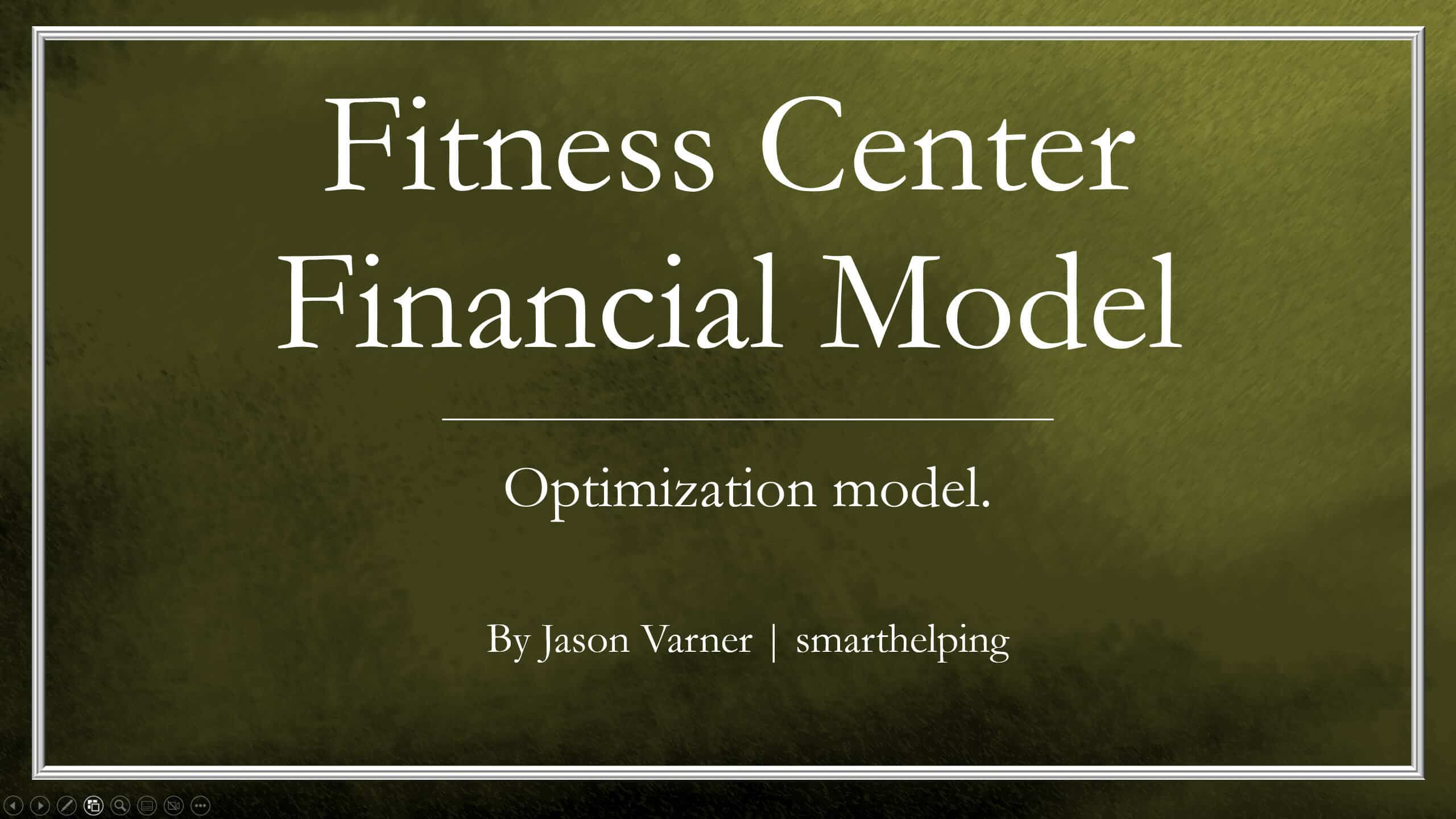Start Up Martial Arts Center Financial Model
Start Up Martial Arts Center Financial Model presents the case of investing in opening a start-up martial arts center and its operations. The model generates the three financial statements, a summary page, a breakeven analysis, and a valuation, along with various feasibility metrics as well as graphs. The financing options for the project include a standard long-term loan, as well as an overdraft facility and of course equity funding from investors.

Start-Up Martial Arts Center Financial Model presents the case of investing in opening a start-up martial arts center and its operations. The model generates the three financial statements, a summary page, a breakeven analysis, and a valuation, along with various feasibility metrics as well as graphs. The financing options for the project include a standard long-term loan, as well as an overdraft facility and, of course, equity funding from investors.
Check the video here:
So a quick overview of the model, in the contents tab, you can see the structure of the model by clicking on any of the headlines to be redirected to the relevant worksheet.
On the manual tab, you are able to feed the general information for the model, such as: project name & title, responsible, the timeline of the model, and the date and currency conventions.
Additionally, there is a description of the color coding of the model in the same tab. Inputs are always depicted with a yellow fill and blue letters, call up (that is direct links from other cells) are filled in light blue with blue letters, while calculations are depicted with white fill and black characters.
There is also a color coding for the various tabs of the model. Yellow tabs are mostly assumptions tabs, grey tabs are calculation tabs, blue tabs are outputs tabs (that is effectively results or graphs), and finally, light blue tabs are admin tabs (for example: the cover page, contents, and checks).
Moving on to the Main Inputs, in this tab, the user needs to adjust the business drivers in the yellow cells. The user starts by filling in the class schedules where the user can set the hours per day, the various class names, hours per week per activity, hours per cohort, and max students per class.
Moving on, the user can set the number of new students per month for the first year and per year from the second year onwards. Additionally, the user can set the number of lost students in a similar manner as with the new students’ inputs.
The next set of assumptions consists of revenue streams per martial art activity and consist of: group lesson fees, set-up fees, exam fees, merchandise sales, and training camps.
The next section consists of direct cost assumptions for the previously mentioned activities, which include teachers’ costs per hour for the group lessons and cost margins for the other revenue activities.
Next, the user needs to set the rent area size and then set the various start-up investment costs such as working capital, floors, mats, walls, furniture, equipment, etc.
Finally, the user has to set the recurring costs per month based on each cost driver, such as rent, utilities, internet, insurance, marketing, etc. The user can also set the cost growth rate per year in the table below.
Moving to the Other Inputs tab, the user can set the tax assumptions, the labor costs in terms of headcount and salary, the depreciation rates for each of the depreciable investment items, and the capex to sales percentage for the continued maintenance required. The user needs to fill in the working capital assumptions in section 5, such as inventory days, receivables days, payables days, etc.
Finally, the user needs to set the percentage financed by debt, the loan duration, and the interest rate.
Calculations: this is where all calculations are performed. The revenues are calculated based on the previous inputs and the growth rates, and by deducting the operating costs, the operating profit is resulting. Based on the assets financed and the gearing of the financing, interest, and depreciation are occurring. By using the working capital assumptions, the impact of the business cycle is presented. Finally, depending on the existing debt financing and forecast assumptions, the loan balances are calculated (Term loan and overdraft).
In the Financial Statements tab: everything is aggregated here into the relevant statements: profit and loss, balance sheet, and cash flow on a yearly basis.
Moving to the Valuation tab, a free cash flow to the firm valuation is performed, leading to an enterprise value. There is also a calculation of the Net Present Value, as well as an Internal Rate of Return, Profitability Index, Payback, and Discounted Payback Period. Additionally, a sensitivity analysis is performed on the equity value of the business by using the discount rate and the growth rate to perpetuity as sensitivity parameters.
In the Graphs tab: Various graphs present the business metrics, revenues, investment & operating expenses, profitability metrics, additionally balance sheet and cash flow metrics, and we finish with discount rates, feasibility metrics, and valuation graphs.
In the Break Even tab, you can find a break-even analysis and see how many students and sales you need to break even.
Checks: A dedicated worksheet that makes sure that everything is working as it should!
In the summary tab, you are able to see a high-level report with the main financial and business ratios. It can be readily printed on one page for your convenience.
Similar Products
Other customers were also interested in...
Paintball Park Business – 10+ Years DCF Mode...
The paintball park business financial model is a comprehensive tool designed to analyze the financia... Read more
Start Up Gym / Fitness Financial Model
Start Up Gym Club Financial Model presents the case of an investment in a gym, fitness club and its ... Read more
Yoga and Pilates Studio DCF Financial Model
Yoga and Pilates Studio DCF Financial Model is a tool that enables you to evaluate the feasibility o... Read more
Fitness Center 10 Year Financial Model
Key logic designed to forecast cash flow up to 10 years for a fitness center that has recurring mont... Read more
Golf Course Financial Model – Startup
A 5-year financial model tailored to starting a golf course and projecting financial performance for... Read more
Padel Club Financial Model – 5 Year Forecast
Padel is a racquet sport that combines the elements of tennis, squash, and badminton. It's usually ... Read more
Private Members Club – Dynamic 10-Year Finan...
User-friendly Financial Model providing an advanced dynamic 10-year financial plan for a startup Mem... Read more
Bike Shop Financial Model Excel Template
Check Our Bike Shop Financial Plan. Includes inputs, outputs and charts to present it in an investor... Read more
Recreation & Community Center – Dynamic 10 Y...
Financial Model presenting a development and operating scenario of a Recreation & Community Cent... Read more
Mini Football Club Financial Model – 5 Year Fore...
Minifootball is probably one of the most popular field sports in the world. Minifootball basically m... Read more
You must log in to submit a review.


























